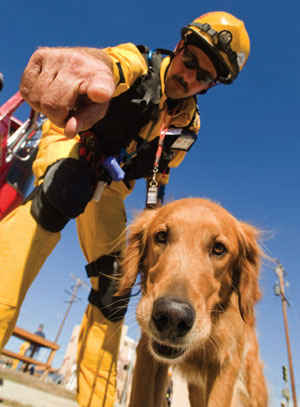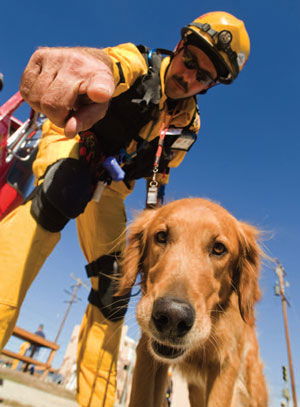

If you were to make a Molotov cocktail, you’d have to wash your hands at least 17 times before a dog would be unable to detect traces of petroleum on your skin. Until fairly recently, this information probably was not much of a concern to would-be flame-throwers.But these days, arsonists of every stripe should beware. While most fire departments have phased out the Dalmatian, fire investigative units have been adding another dog to their teams.
Since the mid-1980s, an elite cadre of canines has been using the ability for smelling in the parts-per-quintillion to help investigators determine whether a fire was deliberately set, and sometimes even who set it. The more than 200 arson dogs (formally known as accelerant- detection dogs) working today can quickly and accurately sniff out tiny amounts of anything from lamp oil to lighter fluid in a scene flooded with several inches of water or covered in snow, ice, mud or thick layers of fire debris.
“The K-9s have the ability to survey a variety of terrain in a fire scene in an incredibly short time,” says Jerry Means, an agent with the Colorado Bureau of Investigations. “The dogs dramatically increase the investigator’s ability to retrieve an accurate reflection of the flammable products present in a fire scene and increase the chances of collecting a positive sample.” Of course, it can be equally important when a dog does not alert to fire-starting substances—helping to rule out arson.
Means investigated approximately 800 fires with his first arson dog, a black Lab named Erin. “We had a fire that occurred in a home where three small children were killed in the blaze,” he says. The fire initially looked like a tragic accident, and an arson dog was not going to be used. “However, considering the magnitude of the loss, it was decided to throw every available tool at the fire investigation.”
GET THE BARK NEWSLETTER IN YOUR INBOX!
Sign up and get the answers to your questions.
Erin alerted a dozen times in the area where it was believed the fire started. Based on these samples tested at the lab, investigators determined that the blaze had been set intentionally. “After four years of investigative work and two separate trials, the children’s father and mother were each convicted of three counts of first-degree murder.”
Means acquired his dogs, first Erin and later Sadie, through a program run by State Farm Insurance Company. Since 1993, the Bloomington, Ill.–based underwriter has teamed up with Maine Specialty Dogs and the Maine Criminal Justice Academy to provide arson dogs— about 10 per year—to communities where at least 50 suspicious fires occur annually. Most dogs are placed so they can help the greatest number of people, and they and their handlers often help neighboring jurisdictions. Overall, 250 State Farm–sponsored teams have set to work in 43 states, three Canadian Provinces and the District of Columbia.
Once an arson dog is certified and placed with a handler, he or she works every day of the year and must be recertified annually. Captain Stephen Baer, founder of the arson dog program at the Seattle Fire Department, recently put his dog Henny through her paces.
Out on the blacktop at a fire-training center south of the city, Baer has set up a simulation. Before I arrive, he has burned a carpet remnant with a torch, squeezed one drop of 50 percent evaporated gasoline in two spots, and burned it a second time. He has also put a tiny drop on a T-shirt in a row of clothes (to simulate a clothing lineup).
At some distance from the demo area, he dons a belt with a kibble pouch. Henny tunes in, ignoring the floating cotton that had captivated her only moments earlier. “She goes from being friendly and looking for Chicken McNuggets on the ground to, Oh, Dad put the belt on, now I’m looking for gasoline,” Baer says. With out the belt, they could walk through a sea of hydrocarbons and she wouldn’t react.
“Seek,” Baer says, as we near the carpet. Henny eagerly noses the ground for a few seconds, then sits on the edge of the carpet and stares at Baer. An alert. “Good,” he says, passing her some kibble. “Show me better.” She circles and sniffs again, then sits in almost the same spot. “Good,” he says in a high, happy voice. More kibble. Baer always asks Henny to double-check and pinpoint the location where she alerts.
If this were a fire scene, Baer would place a clean poker chip on the spot. That’s for the fire investigator, who follows up and determines whether to take a sample and send it to the lab. This process cuts down on time-consuming guesswork in the field. Plus, fewer and better samples cut down on the workload at overburdened crime labs.
In the messy, chaotic aftermath of a real fire, Baer might also point exactly to each spot he wants her to check, saying, “Seek. Seek. Seek.” Arson dogs are taught to discriminate among the variety of scents they might confront at a fire scene —plus deliberate distractions such as beef jerky—and to alert only to substances used to start fires.
Henny joined the Accelerant Detection K-9 Program at the Bureau of Alcohol, Tobacco, Firearms and Explosives (ATF) after flunking out of guide-dog training due to an overactive sniffer. The majority of arson dogs in the United States are trained and certified either by ATF or State Farm. The ATF program dates back to 1984, and 127 accelerant-detection dogs have been placed with agencies in the U.S. and 21 foreign countries since 1991. (It’s a small number, especially when compared to the 595 explosives-detection dogs certified in that same period.)
March 2006, the teammates have been apart only once—during Baer’s honeymoon. They train twice a day to keep Henny’s skills sharp; also, Henny only eats when she’s working. She is always fed from Baer’s hand, as is common with most arson dogs.
Accelerant-detection dogs aren’t limited to fire scenes. Jerry Means’ current arson dog, Sadie, was called in to “survey” two juveniles in a fire at an abandoned flour mill in Longmont, Colo. The suspects originally denied involvement, but when the dog alerted to their shoes, it was only 15 minutes before they confessed to starting the fire.
Arson dogs also make appearances in courtrooms when handlers present evidence—including the dog’s training and experience, and the procedure followed at the incident in question.
What makes a good arson dog? “The ideal dog has high energy,” says Paul Gallagher, the owner-trainer of Maine Specialty Dogs. “It’s basically the semi-problem child.” A former Maine State Police K-9 trainer and supervisor, Gallagher saw one of the first accelerantdetection dogs being trained back in the day, and decided to train one for Maine. This led to training arson dogs for other departments. When he retired from the police force in 1996, he paired up with State Farm to continue the work. State Farm covers the $23,000 training costs for each dog.
Both ATF and State Farm prefer Labradors or Lab-mixes because of their curiosity, energy, tracking ability and easygoing demeanor. Guide dog training “dropouts” are particular favorites. Gunny is fairly typical. He had to find a new career when he slipped a hamburger right off the table in front of a blind person. Now a State Farm–sponsored arson dog in Grand Haven Township, Mich., he’s great at his job because he’s extremely motivated to work for kibble.
Susan Piron of Lake Gaston, N.C., has seen two of the five puppies she raised for Guiding Eyes for the Blind go on to careers in arson detection. In 2008, she was given the option of adopting Elway, a yellow Labrador she’d raised, when he didn’t seem suited for guide dog work. “That was probably the toughest decision,” Piron says, “whether to bring him back to the lake or let him go on to do something for other people and become the best he can be. Elway had a lot of energy and initiative; he needed a job.” Today, he sniffs out accelerants for the Connecticut State Police.
State Farm also enlists one- to twoyear- old dogs from humane societies and rescues, including one Hurricane Katrina rescue.
“We’ve saved a few from being put down,” Gallagher says.
Ultimately, though, it’s not about second chances for dogs so much as saving lives and money. An estimated 32,500 structural fires were set intentionally in 2007, resulting in 295 civilian deaths, according to the National Fire Protection Association’s most recent assessment. The cost in property loss due to arson for 2007 is estimated at around $733 million. Arson is tough to prove, but a dog is a huge asset.
a huge asset. “There is nothing in the pipeline that can equal the scent-ability of the dog that we can take to fire scenes and use,” Gallagher says. “The public needs to know those dogs are out there. It’s an elite group that does a good job … and they need the recognition.”